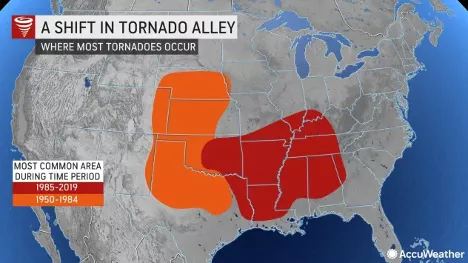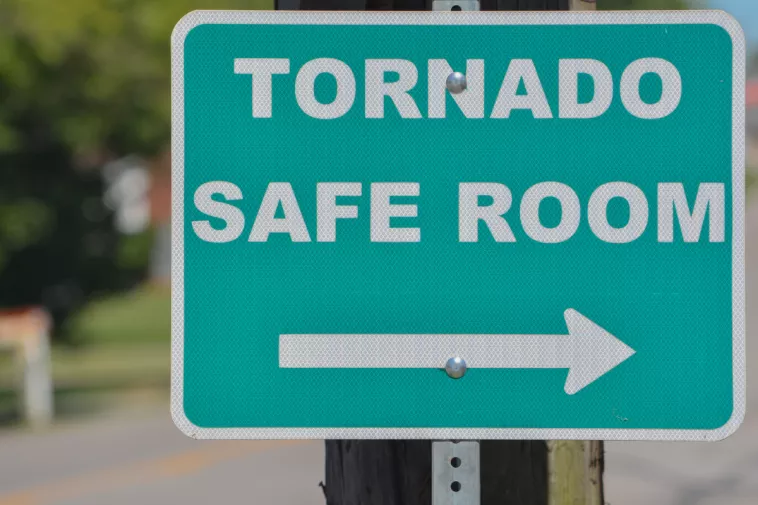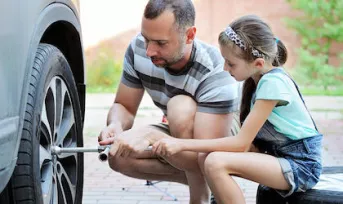

Tornado Guide: How to Prepare and Stay Safe During a Tornado
Tornadoes can strike with little warning, and they can leave behind a trail of mental and physical devastation. But with the right preparation, you can protect yourself, your loved ones, and your home.
Whether you live in a high-risk area or just want to be prepared for the unexpected, understanding preparation steps, what to do during a tornado, and what to do after one is essential.
What is a tornado, and what causes one?
A tornado is a strong and powerful, rotating air column that travels to ground level from a thunderstorm. They are very violent storms that can produce intense winds capable of destroying homes, uprooting trees, and tossing vehicles around in the air. Winds can sometimes exceed 200 mph, causing extreme damage.
Tornadoes form when warm, moist air near the ground collides with cold, dry air just above it. This creates an unstable force in the atmosphere, which leads to strong updrafts and rotation.
From here, a funnel cloud will start to develop, reaching down from the sky to the ground. Once the funnel cloud reaches ground level, it is considered a tornado.
Most tornadoes develop from severe thunderstorms, which are also called supercell storms. While tornadoes can occur anywhere, they are most common in the central United States in an area called "Tornado Alley.”
When is tornado season in the United States?
Tornado season typically starts in March and ends in June, which is when about 70% of tornadoes occur in the United States. However, tornadoes can technically happen any time of year if the conditions are right.
Peak tornado season times by region
- Northern United States: Tornado season peaks in June and July as warmer summer air collides with cooler northern air.
- Central United States: The highest risk is April through June when shifting weather patterns create ideal tornado conditions.
- Southern United States: Peak season is usually March through May, when the warm, moist air from the Gulf of Mexico acts as fuel for severe storms.
Tornado Alley
Tornado Alley is a term used to describe a region in the central United States where tornadoes occur most often. While Tornado Alley has no official boundaries, Texas, Kansas, Nebraska, South Dakota, Missouri, Iowa, and Oklahoma tornadoes are typically the worst.

This region is especially prone to particularly bad tornadoes because it’s where warm, moist air from the Gulf of Mexico clashes with cool, dry air from Canada along with hot, dry air from the Southwest. When these different atmospheres collide, they create the perfect conditions for severe thunderstorms and rotating funnel clouds, leading to tornadoes.
While Tornado Alley sees the most tornado activity, these disastrous storms can and do happen in all 50 states. Other areas, like the Southeast, also experience frequent tornadoes, especially in the fall and winter months.
Tornado watch vs. tornado warning: What’s the difference?
The primary difference between a tornado watch and a tornado warning is the likelihood of a tornado forming. They are not the same, so you should know the difference to help you decide when it’s time to take cover.
Tornado watch
A tornado watch is sent out to the public when weather conditions are favorable for the formation of tornadoes in or around the area. Watches do not mean that a tornado has been spotted or that one is coming. It simply means that tornado conditions are present, and you should stay alert and monitor the situation.
During a tornado watch, you should have a plan ready, but you don’t need to act on it yet. Watches are essentially issued to tell you that a tornado is possible.
Tornado warning
A tornado warning is sent out when a weather radar has detected a tornado or one has been reported by spotters on the ground. Spotters are volunteers who track down severe weather for the National Weather Service. They’re like storm chasers that help make tornado tracking more accurate.
When you see a tornado warning for your area, it means that you should take immediate action to protect yourself. Tornado warnings are typically issued for specific counties or areas, and they indicate a much higher level of risk compared to a tornado watch. Warnings are issued to tell you that a tornado is presently active and definitely headed your way, making it a current threat.
Never ignore a warning. Seek shelter immediately in a safe place like your basement or a room without windows.
How to prepare for a tornado
Tornadoes can form quickly and leave you with minimal time to act, so preparation is crucial. Additionally, the uncertainty of severe weather can be frightening and overwhelming, and having a plan in place can help you stay calm and safe.
- Know the warning signs: Warning signs include dark, greenish skies, large hail, a loud roaring sound like a freight train, and a spinning funnel cloud. Even if a tornado isn’t visible, flying debris or sudden changes in wind direction can signal danger.
- Make an emergency plan: Identify a safe shelter location, decide on a meeting place in case you get separated, and ensure everyone knows emergency contacts. Go over your plan regularly so there’s no confusion when time is critical.
- Put an emergency kit together: Your emergency kit should include flashlights, batteries, a weather radio, bottled water, non-perishable food, first-aid supplies, important documents, and extra clothing. Ensure your kit is in an easily accessible location and check it regularly to replace expired items.
- Create an emergency fund: Setting aside savings for emergencies can help you recover faster. Even small contributions add up over time and provide a financial safety net when you need it most.
- Identify safe shelter areas: The safest place during a tornado is a basement, storm cellar, or a windowless room on the lowest floor of your home. Mobile homes and vehicles are not safe shelter options.
- Secure your property and home: Reinforce windows, secure outdoor furniture, and remove debris that could become dangerous in high winds. If you live in a tornado-prone area, consider installing a storm shelter or reinforced safe room for added protection.
- Make a communication plan: Severe weather can knock out power and cell service, making communication difficult. Designate an out-of-town contact who can relay information and make sure everyone has emergency phone numbers written down in case electronic devices aren’t working.
- Try practice drills: Practice moving to your designated safe shelter and timing how long it takes. Teach kids what to do if they’re home alone, and make sure pets are included in your plan.
What to do during a tornado
When you see or hear a tornado, it’s essential to act quickly. That means gathering your family and pets and getting everyone out of harm’s way. Here’s what to do during a tornado:
- Take shelter immediately: Get to a safe place such as the basement, closet, or bathroom, and keep your head down and covered. Stay away from any windows or doors, as they can break and injure you.
- Protect yourself from flying debris: If possible, use helmets or even pillows to cover your head. Any protection against flying objects is better than nothing.
- Stay informed: Keep your phone nearby so you can stay updated. If the cellphone towers are down, having a weather radio with you can help you stay informed.
- Stay put until the tornado passes: Don’t leave your safe spot until the tornado passes. It’s smart to wait until you get official confirmation from local authorities or a weather station before getting up.
Finding help if you’re impacted by a tornado
After a tornado passes, it’s time to assess the situation around you. Do this by checking yourself, your loved ones, and your pets to make sure nobody is injured. Then you can start contacting people and organizations for help.
Rebuilding your life and home after a tornado is a group and community effort that takes time. Remember to be kind to yourself and reach out if you need any kind of help.
Seek emergency assistance
If you or someone near you is injured, you should call 911 immediately. Or, if you can, drive to the nearest hospital or medical center. Getting treatment for head injuries or open wounds is especially important, as these things can get much worse if left untreated.
If nobody is injured, it’s time to assess your home’s damage. Check your local emergency shelters for lodging availability if your home is damaged or unsafe. Disaster relief organizations like the Red Cross will typically set up temporary shelters after a disaster, which include food and water.
Contact disaster relief organizations
FEMA (Federal Emergency Management Agency) provides disaster aid, temporary housing, and financial assistance for repairs. Visit www.disasterassistance.gov to apply.
The American Red Cross offers emergency shelter, meals, and medical assistance. From their site you can find a local chapter or a shelter.
The Salvation Army and other nonprofits also provide food, clothing, and financial support after disasters.
Be aware of scams, though. After a major disaster happens, you’ll often get many fake phone calls from people posing as disaster relief companies. Never give them any financial or personal information.
Reach out to your insurance providers
If you notice severe damage to your home, car, or belongings, it’s time to report it to the applicable insurance company. Take photos of all damage before making repairs, and ask about temporary housing coverage if your home is unlivable.
You may be reimbursed for any damage caused by the tornado, depending on your specific coverage policy.
Find financial assistance
If you need financial assistance, emergency loans could help weather a disaster.
Advance America offers a range of loans, including Personal Loans and Cash Advances, which can be applied for quickly online or in person. We’re here to help you get back up on your feet after a tornado leaves behind a path of destruction.
Notice: Information provided in this article is for informational purposes only. Consult your attorney or financial advisor about your financial circumstances.


